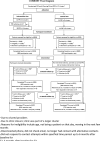A family planning clinic-based intervention to address reproductive coercion: a cluster randomized controlled trial
- PMID: 26892333
- PMCID: PMC4884549
- DOI: 10.1016/j.contraception.2016.02.009
A family planning clinic-based intervention to address reproductive coercion: a cluster randomized controlled trial
Abstract
Objective: We assessed the effectiveness of a provider-delivered intervention targeting reproductive coercion, an important factor in unintended pregnancy.
Study design: We randomized 25 family planning clinics (17 clusters) to deliver an education/counseling intervention or usual care. Reproductive coercion and partner violence victimization at 1 year follow-up were primary outcomes. Unintended pregnancy, recognition of sexual and reproductive coercion, self-efficacy to use and use of harm reduction behaviors to reduce victimization and contraception nonuse, and knowledge and use of partner violence resources were secondary outcomes. Analyses included all available data using an intention-to-treat approach.
Results: Among 4009 females ages 16 to 29 years seeking care, 3687 completed a baseline survey prior to clinic visit from October 2011 to November 2012; 3017 provided data at 12-20weeks post-baseline (T2) and 2926 at 12months post-baseline (T3) (79% retention). Intervention effects were not significant for reproductive coercion [adjusted risk ratio (ARR) 1.50 (95% confidence interval 0.95-2.35)] or partner violence [ARR 1.07 (0.84-1.38)]. Intervention participants reported improved knowledge of partner violence resources [ARR 4.25 (3.29-5.50)] and self-efficacy to enact harm reduction behaviors [adjusted mean difference 0.06 (0.02-0.10)]. In time point-specific models which included moderating effects of exposure to reproductive coercion at baseline, a higher reproductive coercion score at baseline was associated with a decrease in reproductive coercion 1 year later (T3). Use and sharing of the domestic violence hotline number also increased.
Conclusion: This brief clinic intervention did not reduce partner violence victimization. The intervention enhanced two outcomes that may increase safety for women, specifically awareness of partner violence resources and self-efficacy to enact harm reduction behaviors. It also appeared to reduce reproductive coercion among women experiencing multiple forms of such abuse.
Trial registration: ClinicalTrials.gov NCT01459458.
Keywords: Domestic violence; Family planning; Partner violence; Reproductive coercion; Screening; Unintended pregnancy.
Copyright © 2016 Elsevier Inc. All rights reserved.
Figures
References
-
- Keeling J, Birch L. The prevalence rates of domestic abuse in women attending a family planning clinic. J Fam Plann Reprod Health Care. 2004;30:113–4. - PubMed
-
- Miller E, Goldstein S, McCauley HL, Jones KA, Dick RN, Jetton J, et al. A school health center intervention for abusive adolescent relationships: a cluster RCT. Pediatrics. 2015;135(1):76–85. - PubMed
-
- Rickert VI, Wiemann CM, Harrykissoon SD, Berenson AB, Kolb E. The relationship among demographics, reproductive characteristics, and intimate partner violence. Am J Obstet Gynecol. 2002;187:1002–7. - PubMed
Publication types
MeSH terms
Associated data
Grants and funding
LinkOut - more resources
Full Text Sources
Other Literature Sources
Medical



